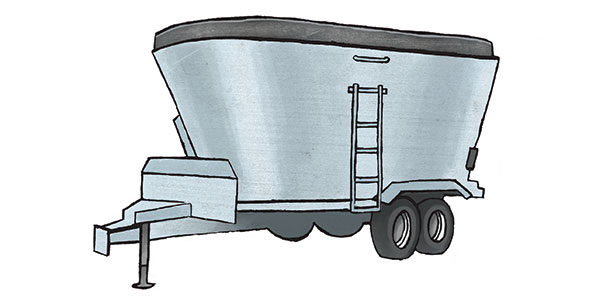A precision feed management system can help improve feed inventory management, employee protocols or the accuracy of income over feed cost values.
However, there are a lot of choices available and doing a quick farm/self-analysis can help you make the right feed management program choice for your operation.
Questions to consider include:
1.How does your feeding team handle change?
Who on your team embraces change? If the answer is not your feed manager, then you may want to implement a system that allows for more control but limits the amount of data entry and configuration.
You may also want to look for as much automation and synchronization as possible to reduce the number of programs data has to be entered into.
For example, you could have your feed management program link to your herd management program to automatically update your pen head counts for precise feed-call weights and accurate data creation on dry matter intake (DMI) per head. Some programs can also automatically retrieve milk weight and price information.
2.Who will be reviewingthe reports and making changes based on the data gathered?
Data is only valuable when it is put to use. As a result, efficiencies from a feed management system can only be achieved when someone actively reviews and uses the information.
The person responsible for reviewing the data can range from the herd nutritionist, a feed manager, herd manager or someone else on the dairy, but someone needs to be responsible so the value can be realized.
3.Is your farm computer current?
Most precision feed management systems do not need a dedicated computer, but they often require the computer to have plenty of memory space. Older computers, like your old Commodore 64, aren’t ideal. Windows 8 and Internet Explorer are preferred.
4.Do you have reasonableon-farm Internet access?
While most programs are available via a USB or CD download, the ability to utilize over-the-phone tech support, automatic record backups, program updates and file sharing with your nutritionist are enhanced and work better with a regular Internet connection.
5.How far does your pay loader travel between loads?
The distance the pay loader travels between loads can impact the number and type of remote displays installed. Can you always see the mixer while getting the next bucket load of feed?
Thinking through how the pay loader travels through the mixing process can impact the amount of technology needed and its use once installed on the farm.
6.Do you load from both sidesof your mixer?
Again, thinking through the process of how feed is mixed can impact technology need and its usage once implemented.
If you load from both sides of the mixer wagon, you may want more than one remote display or a cab control option. Some systems offer an app allowing information on ingredients, loading, etc., to be accessed via a smartphone.
7.How much flexibility do yougive your feeders?
If the answer depends on who is feeding that day, then you will want a system where you can enter a user ID based on who is feeding.
This allows the farm to provide flexibility to the main feeder and have more control over the weekend and holiday feeder to keep things consistent regardless of who is feeding.
8.Do you want a precision feeding system for inventory management, employee management, income over feed cost reports or allof the above?
Most systems have multiple capability levels. Select a system that aligns with your goals. If income over feed cost reports or dry matter efficiency are important, you will want a system that allows you to import milk records and change dry matter percentages.
9.How much technical supportdo you estimate needing?
Are you a techy who only looks at a manual when you get stuck? Or are you the type of person who says “Tell me which buttons to hit so I can get what I want out of it” and just wants it to work? Make sure the system you choose offers the type of support that suits you.
Some systems only offer support during “normal business hours.” Others have an hourly rate, and some can only provide support on the software but know little about the hardware. Be sure to shop and compare the amount and type of support offered.
10.How does your nutritionist analyze your farm’s progress and make adjustments?
If your nutritionist likes to focus on the cows and outside work while they are on-farm, but wants the flexibility to look at your data and input changes from the home or office, there are additional options you may want to explore.
Using a program like TeamViewer via the Internet to jump on to the farm’s computer makes it simple for them to see things and make adjustments, but they could also use other modules to transfer that data and create automated reports for review.
Before investing in precision feeding software, be sure to give careful considerations to herd goals, feeding processes and data capture needs, along with available technology. Taking time to consider all of the variables can help maximize your investment.





